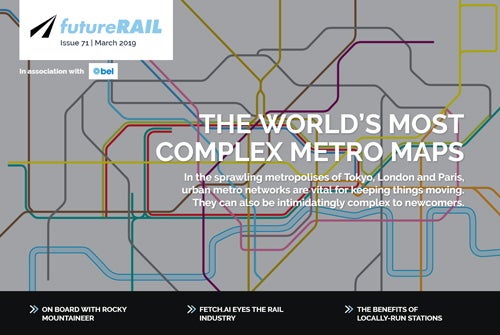
Earlier this year, the UK’s Urban Transport Group published a new report assessing the benefits of greater devolution to local authorities for the country’s railway stations. The report comes at a crucial moment, when the network is being prepped for a “root-and-branch” review of its services. We investigate how devolution could work in this scenario.
Our interactive feature decodes the world’s most complicated metro maps, exploring how these networks have expanded over the years and how their unique designs help passengers navigate these underground mazes.

Discover B2B Marketing That Performs
Combine business intelligence and editorial excellence to reach engaged professionals across 36 leading media platforms.
We also hop on board the Rocky Mountaineer, the Canadian rail-tour company offering stunning vacation packages on four rail routes through British Columbia, Alberta, and the US state of Washington, and chat with the brains behind Fetch.AI, a blockchain and AI start-up which specialises in deploying ‘autonomous agents’ on various networks.
Finally, we round up the innovation priorities for train engines, and talk to Deutsche Bahn about its early adoption of 3D printing technology.
Read the edition in full here.
In this issue
The case for locally run train stations
As the Williams Rail Review gets underway, there are calls for the greater devolution of the running of stations to local government. The case is a strong one, but not all of the UK’s heavily fragmented rail systems may be suited to this shift in power, writes Ross Davies.
Read the article here.

US Tariffs are shifting - will you react or anticipate?
Don’t let policy changes catch you off guard. Stay proactive with real-time data and expert analysis.
By GlobalDataDecoding the urban sprawl: the world’s most complex metro maps
In the sprawling metropolises of Tokyo, London and Paris, urban metro networks are vital for keeping things moving, but laying out these complex systems intuitively for passengers is no easy feat. Joe Baker explores the maps for the most complicated underground networks in the world to find out how they have evolved over the years.
Read the article here.
3D printing in the railway sector with Deutsche Bahn
Companies in the railway industry have started adopting 3D printing technologies to carry out production and maintenance work. How effective is this technology and to what extent is it supporting the industry? Patrick Kingsland speaks with Stefanie Brickwede, head of additive manufacturing at Deutsche Bahn and managing director of Mobility goes Additive.
Read the article here.
Taking the scenic route: on board with Rocky Mountaineer
A Canadian rail-tour company offering vacation packages on four rail routes through British Columbia, Alberta, and the US state of Washington, Rocky Mountaineer is a go-to for dazzling destinations. From cosmopolitan centres to the heart of the mountains, a journey aboard one of its trains can take passengers through some of the best views North America has to offer. Adele Berti takes a look.
Read the article here.
Fetch.AI and the UK rail network’s digital revolution
Blockchain and AI start-up Fetch.AI has joined the Rail Industry Association’s special technical interest group to explore potential uses for the company’s specialised “autonomous agents”.Julian Turner gets the inside track from ecosystem coordinator and software developer Joshua Croft.
Read the article here.
Batteries possibly included: the train engine innovations taking on diesel
Environmental and financial pressures have shunted the rail industry into overdrive in the pursuit of new solutions to make train engines more efficient, cost-effective and quieter. Ross Davies takes a look at how engines are being changed and improved in a bid to meet modern requirements.
Read the article here.
Next issue | April 2019
In the UK, National Rail is trialling new technology that will allow personalised travel information to come through Facebook Messenger, pushing the boundaries of just how personal messaging can get. We find out how close we actually are to devices which can reliably help us beat the crowds.
We also look at another type of alerts, particularly those that take place in case of a rail disaster. We find out some of the most common barriers in the way of a timely rail crisis response, and the most successful solutions on the market.
By profiling the most successful rail regeneration projects, we learn how they can achieve the perfect balance between cost, timeframe, passenger disruption and improved infrastructure.
Finally, we catch up with Noah’s Train, a new climate-minded mobile artwork with a green agenda, as it travels through Europe.





